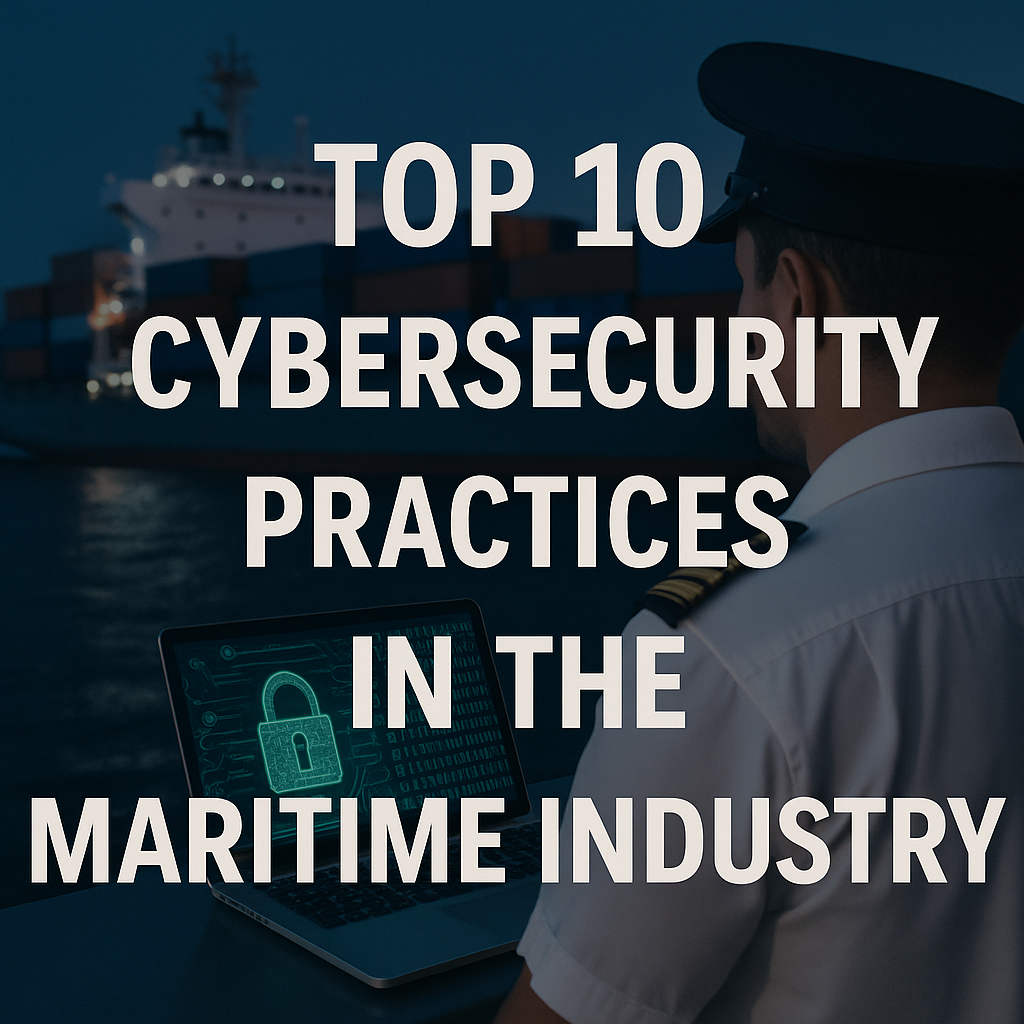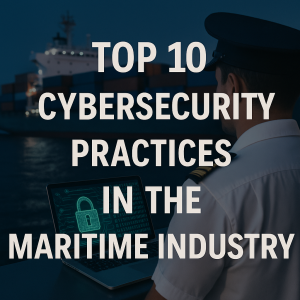Discover the top 10 cybersecurity practices transforming the maritime industry. Learn how shipping companies are combating cyber threats and building resilient digital defenses at sea.
Why Cybersecurity Matters in Modern Maritime Operations
The shipping industry is no longer only about steel and seaworthiness—today, it’s equally about software and systems. From navigation and propulsion to cargo management and communication, modern vessels depend on a vast array of interconnected technologies. But with connectivity comes vulnerability.
The maritime sector, once isolated by geography, is now exposed to cyber threats that can halt operations, endanger lives, and cause severe economic fallout. In 2017, Maersk Line suffered a $300 million loss due to the NotPetya ransomware attack. And that was just the beginning.
Recognizing this, the International Maritime Organization (IMO) implemented cyber risk management requirements under the ISM Code in 2021, making it mandatory for shipowners to address cyber threats in their Safety Management Systems (SMS).
This article explores the top 10 cybersecurity practices that every maritime stakeholder—owners, operators, seafarers, and IT teams—must adopt to defend against evolving digital dangers.
1. Conduct Comprehensive Cyber Risk Assessments
Understanding your vulnerabilities is the first step in managing them. A cyber risk assessment identifies:
-
Network and software weaknesses
-
Critical onboard and shoreside systems
-
Threat vectors (phishing, malware, unauthorized access)
Best Practice: Incorporate cyber risk into your existing Shipboard Safety Management System (SMS) as per IMO Resolution MSC.428(98).
Example: An audit of a tanker fleet revealed outdated antivirus software across ECDIS units, leading to a prioritized system upgrade schedule.
2. Segregate Operational Technology (OT) from Information Technology (IT) Systems
Modern ships have two distinct but often interconnected environments:
-
OT controls navigation, propulsion, ballast systems, etc.
-
IT handles email, logistics, crew management, and reporting.
Cyber intrusions into the IT system can accidentally bridge into OT networks, leading to operational sabotage.
Solution: Implement air gaps, firewalls, and VLAN segmentation to ensure that a phishing email can’t bring down the propulsion system.
3. Keep All Software and Firmware Updated
Unpatched software is a major cyber risk. From shipboard sensors to bridge management systems, outdated software is an open door for attackers.
Recommendations:
-
Maintain a software inventory
-
Schedule regular updates and document all changes
-
Apply vendor-issued security patches without delay
Regulatory Reference: The IMO and BIMCO both emphasize patch management as a cornerstone of maritime cyber hygiene.
4. Control and Monitor External Devices (USB, Laptops)
The 2020 IMO cybersecurity guidelines specifically warn against malware introduced via USB drives and portable computers.
Solution:
-
Disable USB ports or restrict them to read-only
-
Scan all external devices with up-to-date antivirus tools
-
Log and monitor file transfers
Case Study: In 2018, a bulk carrier lost critical engine control due to malware introduced via a service engineer’s infected laptop. Isolating and rebooting systems took 24 hours, delaying the vessel’s schedule.
5. Train Crew and Staff in Cybersecurity Awareness
Your best firewall is an informed crew. Cyberattacks often begin with human error—clicking on malicious links or falling for social engineering scams.
Training Focus Areas:
-
Recognizing phishing emails
-
Strong password practices
-
Avoiding suspicious downloads
-
Reporting unusual activity
Stat: According to ICS, more than 90% of cyber incidents start with a human factor.
6. Enforce Role-Based Access Control (RBAC)
Not everyone needs access to everything. Implementing role-based access ensures personnel only interact with systems necessary for their job functions.
Application Examples:
-
Only officers access ECDIS route uploads
-
Engineers manage automation software, not email servers
-
Passwords are changed after crew changes or personnel rotation
Bonus Tip: Use multi-factor authentication (MFA) where possible.
7. Create and Test an Incident Response Plan
Knowing what to do after a breach is as important as prevention. A cyber incident response plan should define:
-
Detection and containment protocols
-
Roles and responsibilities
-
Communication flows (ship-to-shore, authorities)
-
System restoration and forensics
Practice Makes Perfect: Run cybersecurity drills similar to fire or abandon-ship drills. Simulate a ransomware lockout or GPS spoofing event.
8. Ensure Secure Communication Channels
VHF and satcom are still staples, but modern ships rely on digital communication—email, ECDIS data transfer, voyage planning uploads.
Risk Areas:
-
Spoofed sender addresses
-
Man-in-the-middle attacks on unsecured Wi-Fi
-
Hijacked AIS or GNSS transmissions
Best Practice: Use encrypted email and VPN access for critical updates, especially when connected via public or low-security ports.
9. Monitor Systems with Continuous Cyber Surveillance
Active monitoring allows early detection of unusual behavior—whether it’s an unauthorized login, strange data flow, or system slowdowns.
Tools Include:
-
Intrusion detection systems (IDS)
-
Log analysis and alert software
-
AI-based anomaly detection
Bonus: Remote fleet-wide visibility allows shore teams to oversee cyber threats in real time.
10. Collaborate with External Experts and Authorities
Cybersecurity is not a one-time installation—it’s a dynamic, evolving landscape. Engage with:
-
Class societies (DNV, ABS, Lloyd’s) for cyber audits
-
Regulatory bodies like BIMCO, IMO, and national CERTs
-
Third-party consultants for vulnerability testing and training
Example: Many operators have adopted BIMCO’s “Guidelines on Cyber Security Onboard Ships” as a baseline for compliance and best practice.
Real-World Case Study: Maersk and the NotPetya Cyberattack
In June 2017, a global ransomware attack called NotPetya paralyzed Maersk’s operations. It infected their IT systems, shut down ports, disrupted container tracking, and required 45,000 devices to be reinstalled. Despite being collateral damage in a geopolitical cyberwar, Maersk’s experience became a turning point for the industry.
Lesson Learned: No shipping company is too large—or too remote—to be vulnerable.
FAQ: Maritime Cybersecurity Practices
Q1: Are ships really vulnerable to cyberattacks?
A: Yes. Ships increasingly rely on digital systems like GPS, ECDIS, and remote diagnostics—all of which can be targeted by hackers.
Q2: Is cybersecurity mandatory under IMO rules?
A: Since January 2021, cyber risk management is required under the ISM Code as part of the Safety Management System.
Q3: What are the most common threats?
A: Phishing, malware from USB devices, ransomware, system misconfigurations, and unauthorized network access.
Q4: How often should cyber drills be conducted?
A: Best practice is to conduct them annually, or more frequently if crew turnover is high or systems have changed.
Q5: Who is responsible for cybersecurity onboard?
A: The Company Security Officer (CSO) and Master are ultimately accountable, but all crew share responsibility for vigilance and compliance.
Conclusion
Cybersecurity in the maritime industry is no longer optional—it’s operational. As ships become smarter, they also become more vulnerable. But vulnerability doesn’t mean helplessness. Through proactive measures, crew training, and modern technology, cyber risks can be managed and minimized.
The top 10 cybersecurity practices outlined here offer a blueprint for building digital resilience at sea. Whether you’re a ship manager, IT officer, or seafarer, adopting these strategies ensures not only compliance but the safety of lives, cargo, and the global supply chain.
Call to Action: For cybersecurity audit templates, policy guides, and free crew training modules, visit our Maritime Cybersecurity Resource Center.
References
-
International Maritime Organization. (2021). Guidelines on Maritime Cyber Risk Management. https://www.imo.org
-
BIMCO. (2022). Guidelines on Cyber Security Onboard Ships, Version 4. https://www.bimco.org
-
International Chamber of Shipping. (2020). Cyber Security Workbook for Onboard Ship Use. https://www.ics-shipping.org
-
DNV. (2023). Maritime Cyber Security Insight Report. https://www.dnv.com
-
Maersk. (2018). Cyberattack Recovery Whitepaper. https://www.maersk.com


